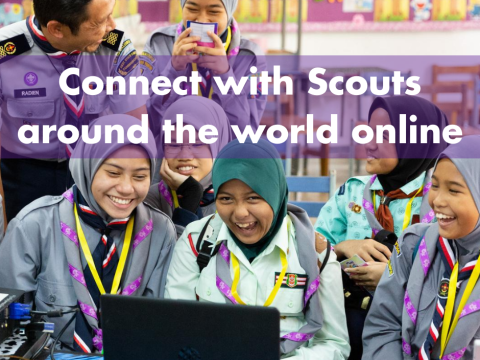How to connect with Scouts around the world online

This article provides Scout Leaders with inspiration and guidance to help safely connect Scouts online with their peers in other parts of the world.
Did you know that there are more than 54 million Scouts around the globe? Our Movement is present in 224 countries and territories!
Connecting our global community is fun and allows us to learn from each other, make lifelong and life-changing friendships, and deepen cultural understanding. These inspiring examples of Scout groups interacting in Afghanistan and the United States of America show us that being more connected makes us better peacebuilders and global citizens.
As Internet access continues to expand and virtual tools allow us to easily connect online, the borders between people and nations begin to erode. Today many Scouts have more opportunities than ever to meet online without having to attend in-person events. The power of meeting Scouts from other places is the realisation that despite different cultures and traditions, anyone wearing a Scout scarf shares the same values and a common commitment to take action and create a better world.
So how can Scouts connect with their peers in other places? Scout Leaders can follow these simple steps to help their Scouts connect in a fun, safe and inclusive way online:
-
Set safety protocols. The safety of young people is always a top priority in Scouting. We strongly recommend that online connections between Scout groups are always facilitated by adult Scout Leaders. Adult Leaders should speak with Scouts and their parents or guardians about Internet dangers and safety before beginning. We encourage all Scouts to get their ‘Be Safe Online!’ certificate. See below for more safety tips.
-
Research. Encourage your Scouts to start exploring other cultures, traditions and countries around the world. You can help them by providing videos and online activities that explain the value of discovering our differences and similarities.
-
Decide. Ask your Scouts what they find most interesting and identify what they want to learn more about. This may be a particular country, climate, religion, language or other aspect of a place. Make sure to consider things such as language barriers, time differences and where Scouting is active (see our list of National Scout Organizations).
-
Contact. Each National Scout Organization has an International Commissioner. You can consult yours and explore WOSM’s Members Portal to find the most up-to-date contact information to reach the International Commissioner from any country. She or he can help you contact a local group’s Scout Leader.
-
Set a date. Once you have contacted the adult Scout leader, agree on a date and time and decide how you would like to connect. You may consider exchanging emails, videos or photos first and arranging a video call as a next step.
To keep Scouts safe from harm, remember the following:
-
Facilitate contact on behalf of Scouts. We never know who is behind a screen. This is why we emphasise the importance of adult Scout Leaders and parents/guardians facilitating online connections to ensure they are connecting Scouts in a safe, supervised environment. Scouts under 18-years-old should never be given direct unsupervised contacts, so all exchanges should be facilitated and supervised.
-
Ensure adequate supervision and parental involvement. Permission from a Scout’s parent or guardian should be sought prior to establishing contact with other Scout groups. The ongoing involvement of parents or guardians is vital in all cases, especially when Scouts are connecting from home. We encourage you to have a discussion with parents on these types of projects so they can understand their roles and responsibilities.
-
Help prevent bullying. While we hope that Scouts are always kind, cyberbullying is still an unfortunate reality, especially for young people. Talk to Scouts about the importance of listening and being kind, especially as they learn from people with different customs. The Anti-Bullying Toolkit can help you and your Scouts understand and prevent bullying. Set clear rules for both sides to ensure a safe environment for contact between the groups. You can also help build trust and improve everyone’s experience by seeking feedback from Scouts.
-
Beware of data sharing. Data theft is a serious problem. While it is unlikely to occur in a situation facilitated by adult Scout Leaders, young people still need to understand that they cannot share identifying information with people they do not know. That can include full names, contact information, school details, private photos and more.
Now you have the information and inspiration to help connect your Scouts with another group! Whether you choose a group in your own country or abroad there is so much to learn from others. Be prepared for discovery as Scouts are bound to gain lots of great questions, insights and understanding from an experience like this.
Share your Scout group’s international experiences by submitting an article on your Scout.org account or by posting on social media and tagging @worldscouting and #Scouts. Be sure to get permission from parents or guardians before sharing photos of Scouts.